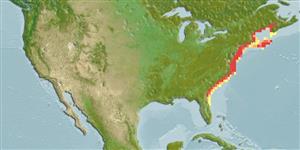Environment: milieu / climate zone / depth range / distribution range
Ecologia
marino; acqua dolce; salmastro demersale; anadromo (Ref. 51243); distribuzione batimetrica 6 - 53 m (Ref. 93286), usually 6 - 34 m (Ref. 93286). Subtropical; 49°N - 28°N, 82°W - 65°W (Ref. 54259)
North America: St. John River in Canada to St. Johns River in Florida, USA.
Length at first maturity / Size / Peso / Age
Maturity: Lm 50.0, range 45 - 55 cm
Max length : 143 cm TL maschio/sesso non determinato; (Ref. 6866); common length : 50.0 cm TL maschio/sesso non determinato; (Ref. 12193); peso massimo pubblicato: 23.0 kg (Ref. 6866); Età massima riportata: 67 anni (Ref. 6866)
Spine dorsali (totale): 0; Raggi dorsali molli (totale): 33-42; Spine anali 0; Raggi anali molli: 18 - 24. Snout short, bluntly V-shaped, not upturned at tip. Barbels short (Ref. 7251). Absence of fontanelle and post dorsal shields. Single row of pre anal shields, 6-11 (Ref. 4639). Dorsal shields 7-13, lateral shields 22-34 (Ref. 4639). Blackish viscera (Ref. 37032). Head and back dark, lower surface white (Ref. 37032). Anal fin origin beneath dorsal fin origin (Ref. 86798).
Inhabit river mouths, lakes, estuaries, and bays; occasionally enters the open sea. Feeds mostly at night over soft substrates; juveniles feed primarily on benthic crustaceans and insects, adults prey on benthic crustaceans, insects and mollusks (Ref. 93252). Maximum known age is 67 years for females and 30 years for males. Flesh of good quality; eggs are suitable for caviar (Ref. 3192).
Page, L.M. and B.M. Burr, 1991. A field guide to freshwater fishes of North America north of Mexico. Houghton Mifflin Company, Boston. 432 p. (Ref. 5723)
IUCN Red List Status (Ref. 130435)
Threat to humans
Harmless
Human uses
Pesca: scarso interesse commerciale; Pesce da pesca sportiva: si; Acquario: Acquari pubblici
Informazioni ulteriori
BibliografiaAcquacolturaProfilo di acquacolturaVarietàGeneticaElectrophoresesEreditarietàMalattieElaborazioneNutrientsMass conversion
CollaboratoriImmaginiStamps, Coins Misc.SuoniCiguateraVelocitàModalità di nuotoArea branchialeOtolithsCervelliVista
Strumenti
Special reports
Download XML
Fonti Internet
Estimates based on models
Preferred temperature (Ref.
123201): 7.5 - 25.5, mean 15.6 °C (based on 138 cells).
Phylogenetic diversity index (Ref.
82804): PD
50 = 0.5000 [Uniqueness, from 0.5 = low to 2.0 = high].
Bayesian length-weight: a=0.00324 (0.00142 - 0.00736), b=3.17 (2.99 - 3.35), in cm total length, based on LWR estimates for this Genus-body shape (Ref.
93245).
Trophic level (Ref.
69278): 3.3 ±0.39 se; based on food items.
Resilienza (Ref.
120179): Molto basso, tempo minimo di raddoppiamento della popolazione più di 14 anni (K=0.04; tm=14-17; tmax=67; Fec=48,000).
Fishing Vulnerability (Ref.
59153): Very high vulnerability (86 of 100).
